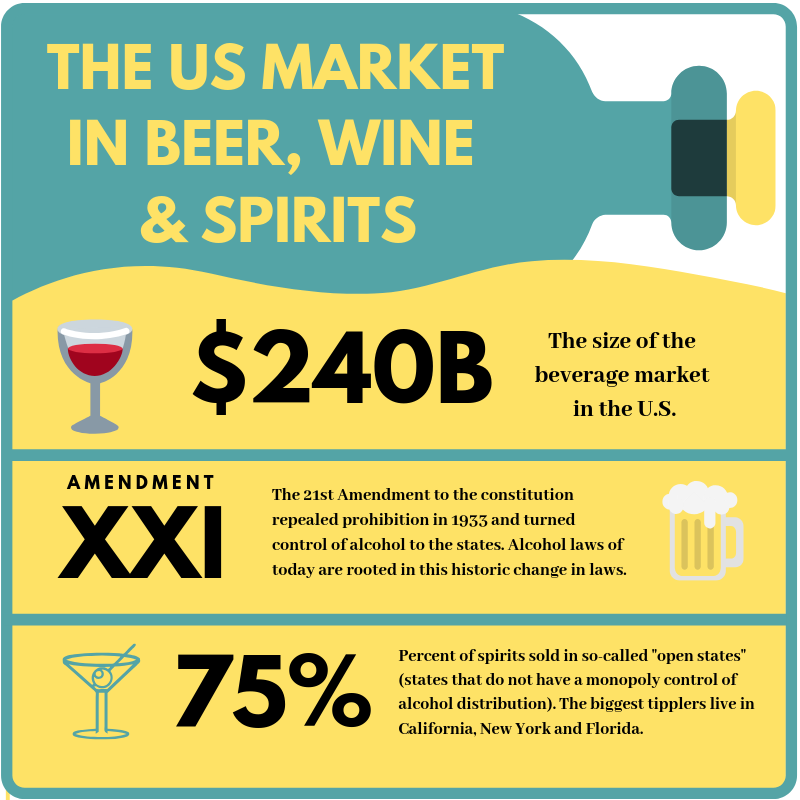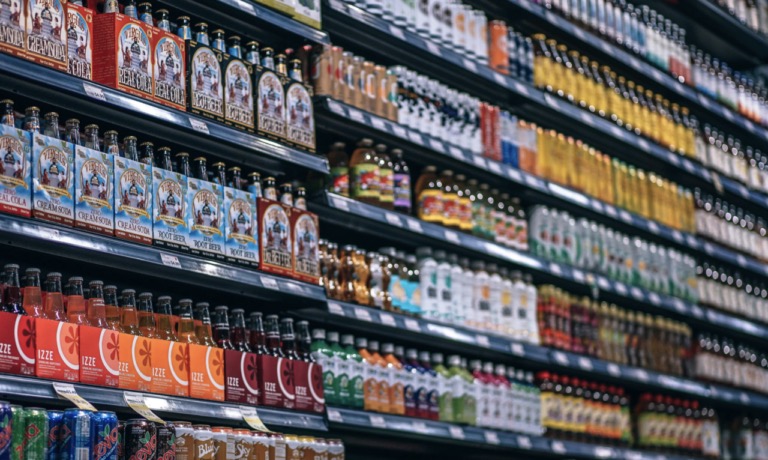Growth Opportunities in the U.S. for Producers of Fine Wines, Spirits and Craft Beer

The U.S. alcoholic beverage market continues to be incredibly strong. It is valued at around 240 billion dollars and continues to grow year over year.
The beverage category has seen especially fast growth in premium and super-premium distilled spirits brands, which grew more than twice as much as non-premium brands in almost every category from 2015-2016. That, combined with a more relaxed regulatory environment and a consumer appetite for new flavors and new brands is shaking up a long-established industry and has made the American market more attractive to newcomers.
A number of challenges exist however, and in this article we outline them, along with some tips for those who would like to enter this market.
The US market for beer, wines, and spirits
Of all of the beverages sold in the U.S., alcohol makes up 16% of the sales by volume, with the largest segment of this market belonging to beer, followed by wines and then distilled spirits.
Sales of alcohol may occur “on-premise” (at a restaurant, bar, or cafe), or “off-premise” (liquor store, wine store or supermarket).
State-by-state regulation in the U.S. is quite complex, and further complicates the landscape for the industry.
Alcohol Regulation in the U.S.: The Three Tier System
Alcohol regulation in the United States traces its roots back to Prohibition, and more specifically the repeal of the 18th Amendment of the constitution in 1933, which had outlawed alcohol in the U.S. in 1919. The adoption of the 21st Amendment put the responsibility of alcohol regulation squarely with the individual states.
The need to regulate and control the alcohol industry led to the wide adoption of what’s called the “three tier system,” which means the production, distribution and retail sale of alcohol is often strictly separated. Producers of wine, for example, cannot distribute their products or sell directly to the consumer. They will typically contract with a distributor who arranges to get their product to a third entity, the retail shop where it can get into the hands of the consumer.
Washington state is the only state in the U.S. that does not follow the three-tier system (producers of wine, for example, are free to contract with retail locations to sell their products), although often the same distribution arrangements apply within this state as are relevant industry-wide.
Further, there are 17 states in the U.S. known as “alcoholic beverage control states,” in which the state maintains a monopoly over the wholesale and/or retail aspect of the some or all of the categories within the alcohol industry (beer, wine and distilled spirits). In these states, consumers might, for example, buy their alcohol from a state-run liquor store.
Local municipalities, with laws that are often rooted in religious values, further complicate this picture. A “dry” county or city is a place where the sale of alcohol beverages is prohibited by local law. This may affect off-premises sales, on-premises sales, or both. While you see “dry” counties mostly in the South, “blue laws” remain on the books in some of the Northeast. “Blue laws” may affect whether liquor stores can be open on Sundays, and may restrict the times at which alcohol can be served at on-premise establishments.
The largest volume of alcohol sales occurs in open states (75%). The largest segment of consumers of wines and spirits resides in California, New York and Florida. About one-quarter of the United States population lives in control states. [Stats: ParkStreet]
Implications for other markets
The “three-tier system” follows a similar separation of producer, distributor and retail in the tobacco market in many states and jurisdictions. Tobacco wholesale distributors who are interest in the cannabis market lobbied in states like Massachusetts to establish a similar scheme.
Breaking into the U.S. beverage market
In keeping with most lucrative markets, the dominant players in alcohol are well-established and have a tendency to stick with what they know works. The sales reps who work with the largest distributors often maintain a roster of well-performing brands in binders as thick as phone books and are not often looking to shake things up with an unproven upstart. So if you are a new brand, how can you approach this market?
When we work with independent foreign brands trying to establish a presence in one of the key U.S. markets for beer, wines or spirits, we often see the most successful companies doing a lot of extra work to build relationships with on-premise and off-premise locations. They rely on brand ambassadors to build those key relationships and accounts and nurture them over time.
Further, these companies take the time to understand the complex regulatory environment that exists in the United States and they take their time to understand the market and target certain geographical areas and market segments strategically.
The Challenges of Reaching the Consumer
When we work with work with newer brands, we usually counsel them to look for a self-starting candidate who doesn’t mind being flexible and pitching in to make sure the key relationships are in place to successfully build the brand. Because we are experienced in placing sales performers in brand-new American territories for foreign companies, we know to focus on candidates who work well autonomously and truly have an entrepreneurial mindset.
Successfully building a brand in one or all of the three key lucrative markets of New York, Florida and California takes time, patience, experimentation and most of all, key sales hires!
See all of our current job openings in beer, wine and spirits here>>


